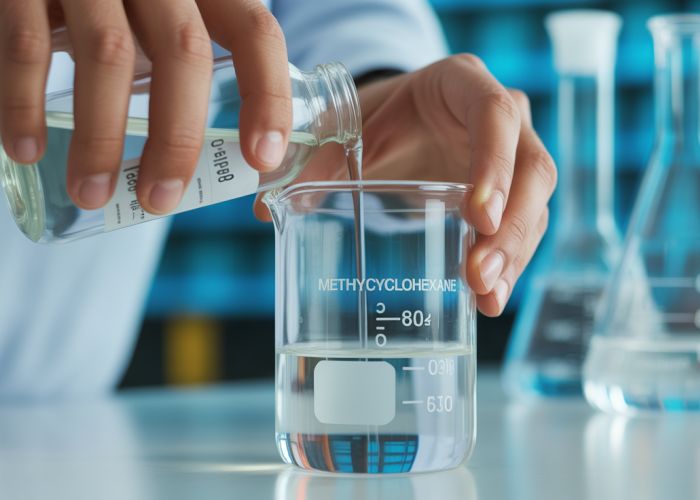Methylcyclohexane, a crucial solvent in many industrial applications, presents specific compatibility challenges, making the selection of appropriate solvents paramount. The Hildebrand solubility parameter, a key tool for predicting miscibility, offers valuable insight into which solvents will interact favorably with methylcyclohexane. This compatibility directly impacts processes within pharmaceutical manufacturing, where the choice of reaction and purification solvents is critical. Understanding the principles of polar and nonpolar interactions clarifies why certain classes of compounds exhibit better solvency properties with methylcyclohexane. Evaluating these relationships allows for the identification of a solvent compatible with methylclclohexane that optimizes reaction yields and product purity within complex chemical syntheses.

Methylcyclohexane: Finding Perfect Solvent Matches? Find Out!
This article explores the characteristics of methylcyclohexane and, crucially, how to determine which solvents are solvent compatible with methylcyclohexane. Understanding solvent compatibility is vital for various applications, ranging from chemical reactions to industrial cleaning processes.
Understanding Methylcyclohexane’s Properties
Before delving into compatibility, we need a good understanding of methylcyclohexane itself.
Chemical Structure and Key Characteristics
Methylcyclohexane is a cycloalkane – a saturated hydrocarbon ring with a methyl (CH3) group attached. This simple structure imparts several important properties:
- Non-polar nature: Due to the predominantly carbon-hydrogen bonds, methylcyclohexane is a non-polar solvent. This is a key factor in determining its compatibility with other substances.
- Low polarity: Its slight branching makes methylcyclohexane non-polar.
- Relatively inert: It is reasonably chemically stable, resisting reaction with many common reagents.
- Low boiling point: Methylcyclohexane has a relatively low boiling point compared to larger cyclic alkanes, which is significant for distillation and solvent removal processes.
- Density: Has a density of 0.769 g/cm3.
Common Uses of Methylcyclohexane
Because of its properties, methylcyclohexane finds uses in several areas:
- Solvent: It is used as a solvent in various chemical reactions and industrial processes.
- Intermediate: As an intermediate in organic synthesis.
- Calibration Standard: Used as a standard for calibrating instruments and equipment.
Factors Determining Solvent Compatibility with Methylcyclohexane
Solvent compatibility isn’t simply a yes/no answer; it’s a spectrum influenced by several factors. The most important of these are:
Polarity
As methylcyclohexane is non-polar, it is most compatible with other non-polar solvents. "Like dissolves like" is the general rule.
-
Good Matches: Alkanes (hexane, heptane), aromatic hydrocarbons (toluene, benzene), and other non-polar cyclic alkanes.
-
Poor Matches: Polar solvents such as water, alcohols (ethanol, methanol), and amides (dimethylformamide, DMF) are generally immiscible with methylcyclohexane. This is due to the strong intermolecular forces (hydrogen bonding, dipole-dipole interactions) present in polar solvents, which are not present in methylcyclohexane.
Hansen Solubility Parameters
Hansen Solubility Parameters (HSPs) provide a more quantitative approach to predicting solvent compatibility. HSPs break down the total solubility parameter into three components:
- δd (Dispersion): Represents the forces due to London dispersion forces.
- δp (Polar): Represents the forces due to dipole-dipole intermolecular forces.
- δh (Hydrogen Bonding): Represents the forces due to hydrogen bonds.
To determine if a solvent is solvent compatible with methylcyclohexane, compare its HSP values to those of methylcyclohexane:
| Solvent | δd | δp | δh |
|---|---|---|---|
| Methylcyclohexane | 16.0 | 0.0 | 0.2 |
| Hexane | 14.9 | 0.0 | 0.0 |
| Toluene | 18.0 | 1.4 | 2.0 |
| Water | 15.5 | 16.0 | 42.3 |
| Ethanol | 15.8 | 8.8 | 19.4 |
Note: HSP values are in MPa1/2
The closer the HSP values of a solvent are to those of methylcyclohexane, the more likely they are to be miscible.
Miscibility Tests
The ultimate test of compatibility is direct observation through miscibility tests.
- Procedure: Mix equal volumes of methylcyclohexane and the solvent in question.
- Observation: Observe for phase separation, cloudiness, or any other indication of immiscibility.
- Interpretation: If the mixture remains clear and homogeneous, the solvents are likely compatible.
Considerations for Specific Applications
While general rules apply, solvent compatibility can be application-dependent.
Reactions
In chemical reactions, the choice of solvent can influence reaction rate, equilibrium, and selectivity. In general, methylcyclohexane, as a non-polar solvent, tends to perform best in reactions that involve non-polar or weakly polar reactants and products.
Extractions
In extraction processes, solvent compatibility plays a crucial role in achieving efficient separation of desired compounds. Methylcyclohexane’s non-polar nature makes it a good choice for extracting non-polar substances from aqueous or polar mixtures.
FAQs: Methylcyclohexane Solvent Matching
Here are some frequently asked questions to further clarify the selection of suitable solvents compatible with methylcyclohexane.
What makes methylcyclohexane a useful solvent?
Methylcyclohexane is a non-polar, alicyclic hydrocarbon solvent. It exhibits excellent solvency for non-polar compounds. Its relatively low boiling point and high purity make it suitable for many chemical processes. It can be a great solvent compatible with methylclclohexane.
What types of solvents are compatible with methylcyclohexane?
Generally, other non-polar solvents are most miscible and compatible with methylcyclohexane. This includes solvents like hexane, heptane, benzene, toluene, and other aliphatic or aromatic hydrocarbons.
Why is solvent compatibility important?
Solvent compatibility ensures a stable and homogenous solution, preventing phase separation or precipitation. Incompatible solvents can lead to undesirable reaction outcomes, poor solubility, or difficulty in downstream processing. For example, if you want to find solvent compatible with methylclclohexane, you have to check its properties.
Are there any solvents that should not be mixed with methylcyclohexane?
Polar solvents, such as water, alcohols (like ethanol or methanol), or highly polar aprotic solvents (like DMSO or DMF), should generally be avoided. These solvents are typically immiscible and can lead to phase separation. So when you want to choose solvent compatible with methylclclohexane, check the polarity.
So, hopefully, you’ve got a better handle on finding a solvent compatible with methylclclohexane! It can feel like a puzzle sometimes, but with a little knowledge, you’re well on your way. Good luck with your experiments!



